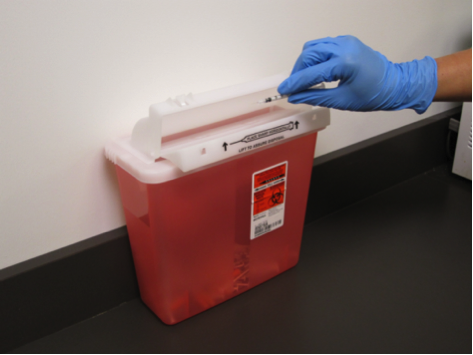Each year nearly 5.2 million healthcare workers are at risk of contracting infectious diseases like HIV and hepatitis as a result of occupational injuries such as accidental needle sticks. According to the Center for Disease Control and Prevention about 385,000 such injuries actually occur each year to hospital employees. The CDC also estimates that 62 to 88 percent of them could be avoided by using safer medical devices as well as proper disposal of them.
Given these facts its no surprise that Southern Oregon University took quick action when a custodian got stuck with a stray insulin needle while searching through the lost and found last month. After a similar needle was found on a counter top in a nearby location in the Stevenson Union the following day, SOU’s Environmental Health and Safety department called for the immediate placement of red bio-hazard waste containers in every bathroom on campus to prevent misplacement of needles or syringes and any further accidents.
“Having stray needles like that can mean exposure to blood borne pathogens and serious health risks,” said Russell Deen the manager of SOU’s environmental health and safety department, who has expressed the need for these containers in order to maintain the health and well being of the students and staff members. The waste containers are meant to encourage students with health issues such as diabetes to properly dispose of their medical devices, as opposed to leaving them in places that could possibly harm others.
Although the intended use of the containers is clearly recognized by the faculty who initiated the program, some staff members are skeptical as to whether or not students will properly utilize them.
Brent Cummings a student coordinator at the Hannon Library commented on the issue stating that “there’s no description on the boxes for what they’re for, so students may not know how to use them.” Another staff member who works the night shift as a janitor stated that she has not had to empty a single one out since they were brought in. As the containers are a new addition to the campus this year, students may have yet to realize their purpose. Despite these concerns the University Environmental Health and Safety department is sure that the waste containers will contribute to the health and safety of the campus and will provide a safer learning environment for students as well as its staff members.
The most common type of waste normally collected in these containers are needles used for insulin injections. Students and staff, however, are able to use the boxes for proper disposal of any biological waste. These include anything that might qualify as biologically hazardous material such as needles, syringes, or even broken glass with visible traces of blood.
After collected in these containers the waste is bagged and labeled as “bio-hazard” by custodians then taken by Recology, Ashland’s sanitary service. From there bio-hazard waste is collected all throughout Ashland, then taken to Rogue Disposal.




